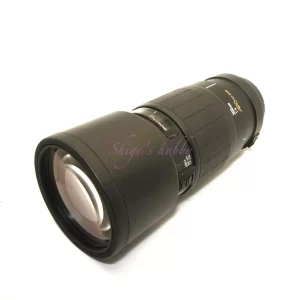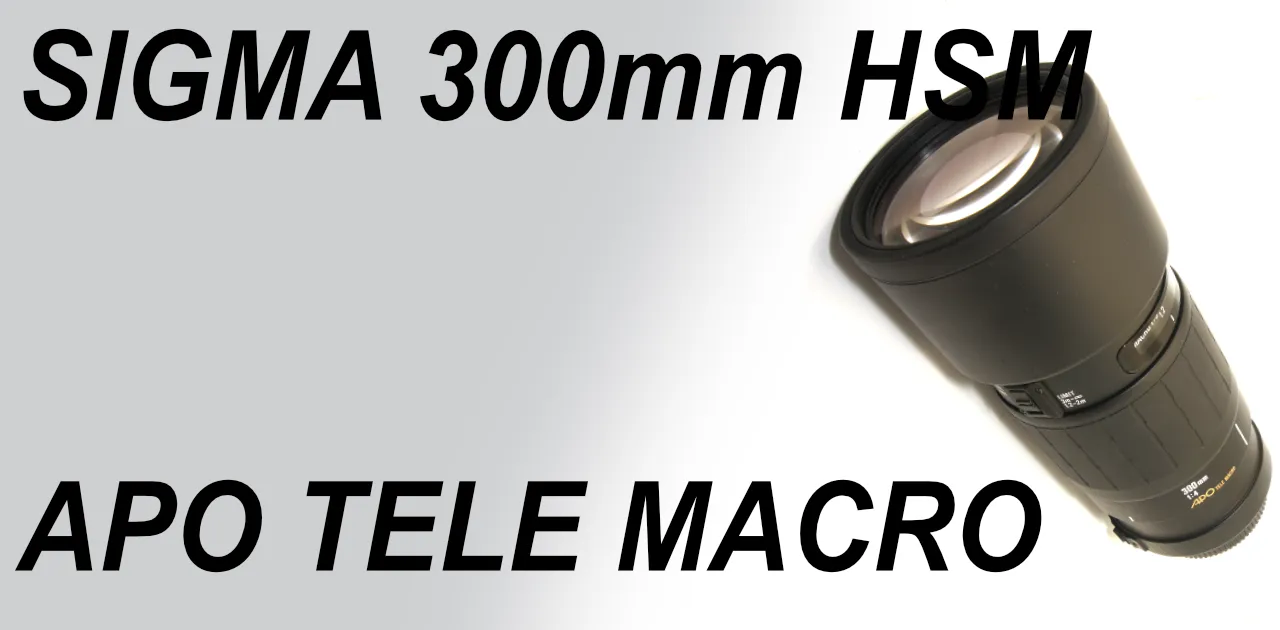Last updated on 2025-09-19
A review and sample images of the Sigma AF APO TELE MACRO 300mm F4 with the SIGMA SD10.
- Please see the disclaimer regarding advertising here.
- Italicized links in the text are advertisement links that take you to other sites.
Table of contents

Gallery
The example photo was taken using a SIGMA SD10.
Review

1.Overview
The Sigma AF APO TELE MACRO 300mm F4 HSM is a telephoto lens released by Sigma in 1995.
The lens name is APO TELE MACRO HSM, where “APO” stands for “apochromatic correction” and reduces chromatic aberration, “TELE” stands for telephoto, “MACRO” stands for close-up photography, and “HSM” stands for ultrasonic motor.
Since it is a prime lens, it has a focus ring, a focusing distance limit switch (no limit, infinity to 3m, 3m to 1.2m), and an AF/MF switch.
The hood is built-in, but it is not very long even when pulled out, so it does not block light very well.
2.Usability
The Sigma AF APO TELE MACRO 300mm F4 HSM is a so-called 300mm F4 lens. In the 1990s, if the 300mm F2.8 was the pinnacle of telephoto lenses available to amateur photographers, then this lens was one step slower but cheaper, and the camera manufacturer itself sold it to accommodate those who could not afford the 300mm F2.8.
In contrast, third-party Tokina and Tamron sold the 300mm F2.8 at about the same price as the 300mm F4, and did not release a lens with the 300mm F4 specification. Sigma, which is also a camera manufacturer, sold both the 300mm F2.8 and 300mm F4 lenses.
Like the 400mm F5.6, this lens has been used since the Sigma SD10, and when cropped to the sensor size of the SD10, it is multiplied by 1.7, giving it a focal length of 510mm.
The lens uses internal focus, so the overall length of the lens does not change when in use.
The autofocus speed depends largely on the camera’s performance, so the evaluation varies depending on the camera, but as far as I used it with the SD10 and SD14, the early HSM (High Speed Motor / Canon calls USM) installed in this lens is not fast and has a lot of instantaneous power. However, the advantage of the ultrasonic motor is that it drives the lens quietly and smoothly, which is a pleasant feeling as a tool. This motor is said to break down often, but the lens I own has not had any problems even after more than 20 years, probably because of the frequency of use.
The image quality is not as sharp as modern lenses, but it shows a reasonable sense of resolution and color, and with a pixel count of about the SD10, you can get a relatively satisfying picture. The sample is a still photo, but in the shadows it produces many blurry photos.
3.Summary
In conclusion, to sum up the SIGMA AF APO TELE MACRO 300mm F4 HSM, it is compact and easy to carry, and with a minimum shooting distance of 1.2m, you can easily enjoy telephoto photography.
It is a useful lens for shooting cats and wild birds outdoors, or at zoos.
Specification and Competitor
Representative 300mm F4 lenses include the following. Nikon also released a 300mm F4 lens with a normal motor before it was equipped with an ultrasonic motor.
- CANON EF 300mm F4L USM
- NIKON AF-S 300mm F4
- MINOLTA 300mm F4 APO G HS
- SIGMA APO TELE MACRO 300mm F4 HSM
In the 2000s, the focal length and brightness of 300mm F4 was covered by zoom lenses.
Side talk
By replacing the mount parts and reconnecting the wiring, I was able to convert an old Sigma EF mount lens for Canon EF to a Sigma SA mount.
I previously posted a detailed article with photos, but since there is probably no demand for it now, I will leave a simple record of how to do it.
This modified lens allows AF shooting using the Sigma SA 1.4x teleconverter and 2x teleconverter. The AF focusing accuracy decreases, but it can be captured unless it is very fast. However, the image, which is already slightly lacking in sharpness, becomes even worse, so it is not very practical.
The work from this point on is not recommended for modification.
We cannot be held responsible for any broken or junk lenses that occur if you do the same work, so please carry out the work at your own risk.
What to prepare
- Sigma SA mount lens – Since you will only be using the mount part, it is best to find a cheap lens.
- Sigma EF mount lens – This will be the lens you will be modifying, so there will be no warranty and you will be prepared to break it if you fail.
- Soldering iron
- Solder
- Electrical wire (thin)
Work
- Remove the SA mount screw from the Sigma SA mount lens and remove the mount.
- Remove the soldered signal flex cable from the mount. (Be careful not to get burned as the soldering iron will melt the connection.)
- Remove the EF mount screw from the Sigma EF mount lens and remove the mount.
- Remove the soldered signal flex cable from the mount. (Be careful not to get burned as the soldering iron will melt the connection.)
- Connect the SA mount removed in steps 1 and 2 to the flex cable coming out of the original EF mount lens in the same order. It is difficult to attach the flex cable directly to the mount, so it is easier to connect the mount and flex cable with a thin electric wire. If you attach it from the end, you will have one extra terminal, but don’t worry about it.
- When you’re done, push the cable into the lens, attach the SA mount to the lens and screw it in place. The screw holes were perfectly positioned so it was no trouble at all.
- This allows you to replace your Sigma EF mount lens with a Sigma SA mount lens.
- You can turn the remaining lens into an EF mount lens, but there’s a high chance that the lens won’t be recognized by Canon cameras due to a lens ROM issue*1, so I think it’s a waste of time.
- *1: In the past, there were companies that created firmware (ROM) for third-party lenses through reverse engineering without receiving official permission from the camera manufacturer. Since freeloading on cameras was not tolerated, camera manufacturers would determine whether the firmware (ROM) installed on the lens attached to the camera was genuine or not, and third-party lenses with non-genuine firmware would not function properly.
Sigma’s EF and SA mounts not only have the same flange focal length, but also almost the same electrical signal. Of course, there is a possibility that the motor may burn out or the lens may malfunction due to minor differences in operating voltage or control specifications, but so far it has been working without any problems.
As with the 40mm F5.6, there is little demand for SA mount lenses, so I have not sold them and still have them. When I use it occasionally, it does not have the sharpness of modern lenses, but I can enjoy the depiction of an old telephoto lens.
| Items | APO TELE MACRO 300mm HSM | AF-S 300mm F4 | EF 300mm F4L USM | MINOLTA 300mm F4 APO G HS |
| Sensor size | 35mm Full Frame | 35mm Full Frame | 35mm Full Frame | 35mm Full Frame |
| Focal length(mm) | 300 | 300 | 300 | 300 |
| Max aperture | 4 | 4 | 4 | 4 |
| Min aperture | 32 | 32 | 32 | 32 |
| Leaf blade | 9 | 9 | 8 | 9 |
| Lens Construction | 10 elements in 7 groups | 10 elements in 6 groups | 8 elements in 7 groups | 9 elements in 7 groups |
| Min distance(m) | 1.2 | 1.45 | 2.5 | 2.5 |
| Lens length(mm) | 195(SA) | 222.5(F) | 213.5(EF) | 220.5(A) |
| Max diameter(mm) | 87 | 90 | 90 | 82+α |
| Filter Size(mm) | 77 | 77 | 77 | 82(front) 42(rear) |
| Weight(g) | 1,298(SA) Without tripod mount | 1300(F) Without tripod mount | 1,165(EF) | 1,410(A) |
| accessories | Front cap Rear cap Case | Front cap Rear cap Case | Front cap Rear cap Case | Front cap Rear cap Hood Case |
| Release date | 1995 | 2001 | 1991.12 | 1994 |
| Lens mount | CANON EF SIGMA-SA NIKON-F(No HSM) PENTAX-K(No HSM) SONY-A(No HSM) | NIKON-F | CANON EF | SONY-A |
| Price(Yen/No-tax) | – | ¥185,000 | ¥149,000 | – |
Reference links
- dyxum.dom / Sigma 300mm F4 Macro APO
- SIGMA 300mm F2.8・WebArchive
- SIGMA 300mm F4・WebArchive
- SIGMA 400mm F5.6・WebArchive
- SIGMA 500mm F4.5・WebArchive
Affiliate link
- Sigma・Ads by Amazon
- Sigma lens・Ads by Amazon
- Sigma books・Ads by Amazon
- NIKON-F(No HSM)・Ads by Amazon

Amazon Prime Sale
Update History
- 2025.9.16
- 2024.07.03


Be First to Comment